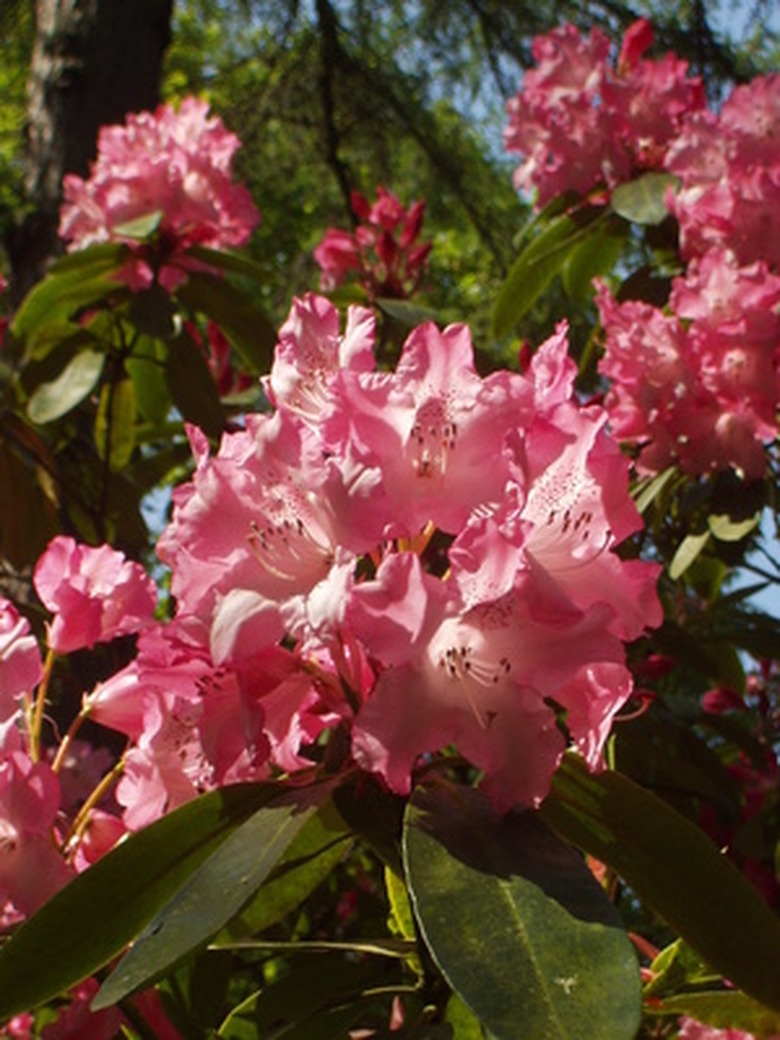Leaf Diseases Of The Rhododendron
Rhododendrons are woody, evergreen shrubs that bloom in large clusters of white, pink or red flowers. The Rhododendron genus encompasses a wide range of shrub species, including azaleas. Rhododendron shrubs are susceptible to many different diseases, both fungal and viral in nature. Most diseases don't warrant chemical treatment, except for in cases of severe infection. Thankfully, many cultivated varieties of rhododendron species are engineered for disease resistance.
Rusts
Rusts are caused by a wide range of fungal diseases and tend to create yellow or brown blotches on the upper surfaces of the rhododendron's leaves and reddish, orange or yellowish-orange spots on the undersides. The leaves will also have orange gelatinous spots and can become distorted or stunted. Treat rhododendrons for rust diseases by raking away infected leaves, pruning off diseased leaves, twigs and branches, and then destroying or discarding the infected plant parts. You may also apply an appropriate fungicide to control the disease in severe infections.
- Rhododendrons are woody, evergreen shrubs that bloom in large clusters of white, pink or red flowers.
- Treat rhododendrons for rust diseases by raking away infected leaves, pruning off diseased leaves, twigs and branches, and then destroying or discarding the infected plant parts.
Powdery Mildew
Powdery mildew is a common fungal disease that's easily recognized by the white, powdery spores that cover the leaf surfaces. Powdery mildew can also infect new buds, shoots and flowers on rhododendrons, causing new growth to become distorted and stunted. This fungal disease is most prevalent when air temperatures are 50 to 70 degrees F and relative humidity is 90 percent or higher. Cultivated varieties of the species Rhododendron yakushimanum and R. macrophyllum, as well as R. 'Palestrina' and R. 'Nova Zembla,' are resistant to powdery mildew, but other species and cultivars may need chemical treatment to control severe infections. Fungicides like horticultural oils, neem oil, sulfur and potassium bicarbonate can eradicate powdery mildew diseases on rhododendrons.
Leaf Gall
Caused by the fungus Exobasidium vaccinii, leaf gall disease usually infects rhododendrons during wet weather. Leaf gall causes distorted, crisp and thickened leaves on infected rhododendrons, as well as white to pinkish spore growth on the affected plant tissues. Treat rhododendrons infected with leaf gall by pruning away the diseased plant parts, raking away and discarding fallen leaves, pruning only when conditions are dry, and avoiding any wetting of the foliage when watering.
- Powdery mildew is a common fungal disease that's easily recognized by the white, powdery spores that cover the leaf surfaces.
- Treat rhododendrons infected with leaf gall by pruning away the diseased plant parts, raking away and discarding fallen leaves, pruning only when conditions are dry, and avoiding any wetting of the foliage when watering.
Phyllosticta Leaf Spot
Phyllosticta leaf spot is a fungal disease that causes small dots of yellowish-tan to brownish spots on the rhododendron's leaf surfaces. Severe infections can cause defoliation of the shrubs. Control Phyllosticta leaf spot disease by raking up all fallen leaves and avoiding the use of overhead watering to prevent wetting of the leaves.
Necrotic Ring Spot
Necrotic ring spot is a virus that causes light-colored spots or streaks on the rhododendron's leaves. Infected leaves can become dwarfed and distorted, but the virus rarely causes any serious damage to rhododendron shrubs. There is no cure for the necrotic ring spot virus, but you can control the disease by properly watering, fertilizing and pruning infected rhododendrons to keep the shrubs strong and healthy.
Botrytis Blight
A disease that's caused by the fungus Botrytis cinerea, Botrytis blight creates discoloration or spotting of the leaves and shoots. This disease can also cause the buds to rot; the leaves and shoots to wilt, decay and fall off; and grayish-brown spore growths on the leaves and flowers. Botrytis blight is most prevalent during humid conditions and in severe cases can cause twig dieback and flower buds that don't bloom. Treat Botrytis blight in your rhododendrons by raking away and discarding all fallen leaves and flowers, pruning out the dead or dying plant parts, and avoiding wetting the leaves when watering.
- Phyllosticta leaf spot is a fungal disease that causes small dots of yellowish-tan to brownish spots on the rhododendron's leaf surfaces.
- Control Phyllosticta leaf spot disease by raking up all fallen leaves and avoiding the use of overhead watering to prevent wetting of the leaves.
